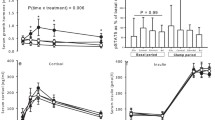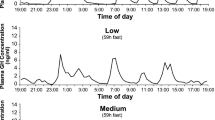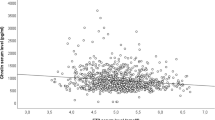Abstract
Patients with Graves’ thyrotoxicosis lose weight despite increased appetite and food intake, thus suggesting a disturbed balance between energy intake and expenditure. Underlying mechanisms are not fully elucidated. The objective of this study was to investigate whether hormonal factors, known to affect hunger/satiety, change significantly over time as pharmacological treatment turns hyperthyroidism into euthyroidism. For that purpose 11 patients with Graves’ thyrotoxicosis were given thiamazole and I-thyroxine for 18–20 mo. They were investigated on three occasions: Test 1: before pharmacological therapy; Test 2: during medication; Test 3: a few months after conclusion of the pharmacological treatment. Sixteen healthy subjects were also investigated for comparison. The participants were fasted overnight. Blood samples for determination of plasma glucose and serum concentrations of free T3 and T4, TSH, albumin, cortisol, insulin, GH, IGF-1, IGFBP-1, leptin, and ghrelin were drawn in the morning from an antecubital vein. Laboratory data obtained in test 1 were statistically compared with those in tests 2 and 3. The study showed that the free T3 level declined from 42.8±4.3 pmol/L in test 1 to 6.0±0.8 pmol/L in test 2 (85±2% decline), and 5.5±0.3 pmol/L in test 3 (86±2% decline). The free T4 level fell concomitantly from 65.2±4.8 to 16.6±1.7 and 14.4±1.2 pmol/L. The glucose level was significantly higher during hyperthyroidism (test 1) than during euthyroidism (tests 2 and 3), whereas cortisol, insulin, GH, IGF-1, and leptin levels were similar. The IGFBP-1 level was initially high (48.8±8.5 µg/L in test 1), but with a relative decline in free T3 of 85±2% (test 2) the IGFBP-1 level declined by 34±13%, and with a free T3 decline of 86±2% (test 3) the binding protein fell by 39±29%. This brought about increased IGF-1 bioavailability as reflected by a rising IGF-1/IGFBP-1 ratio from 5.1±1.1 to 13.8±2.9 (p<0.01). The ghrelin level was low (2454±304 ng/L) in test 1. It increased to 3127±397 ng/L in test 2 (p<0.05), and to 3348±279 ng/L in test 3 (p<0.01). Conclusion: Both ghrelin secretion and IGF-1 bioavailability are low in patients with untreated thyrotoxicosis, but increase markedly as pharmacotherapy makes them euthyroid. These metabolic changes may be caused by the transition of hyperthyroidism into euthyroidism rather than by the pharmacotherapy per se, since the metabolic changes prevailed also in the posttreatment period.
Similar content being viewed by others
References
Ingbar, S. H. (1985). In: Textbook of endocrinology. Wilson, J. D. and Foster, D. W. (eds.). Saunders: Philadelphia, PA.
Havel, P. J. (2001). Exp. Biol. Med. 226, 963–977.
Weigle, D. S., Bukowski, T., Foster, D., et al. (1995). J. Clin. Invest. 96, 2065–2070.
Rink, T. J. (1995). Nature 372, 406–407.
Romon, M., Lebel, P., Velly, C., Marecaux, N., Fruchart, J. C., and Dallongeville, J. (1999). Am. J. Physiol. 277, E855-E861.
Stephens, T. W., Basinski, M., Bristow, P. K., et al. (1995). Nature 377, 530–532.
Rohner-Jeanrenaud, F. and Jeanrenaud, B. (1996). N. Engl. J. Med. 334, 324–325.
Flood, J. F. and Morley, J. E. (1991). Peptides 12, 1329–1332.
Boden, G., Cheu, X., Kolaczynski, J. W., and Polansky, M. (1997). J. Clin. Invest. 100, 1107–1113.
Elimam, A., Knutsson, U., Brönnegård, M., Stierna, P., Albertsson-Wikland, K., and Marcus, C. (1998). Eur. J. Endocrinol. 139, 615–620.
Nakazato, M., Murakami, N., Date, Y., et al. (2001). Nature 409, 194–198.
Wren, A. M., Seal, L. J., Cohen, M. A., et al. (2001). J. Clin. Endocrinol. Metab. 86, 5992–5995.
Shintani, M., Ogawa, Y., Ebihara, K., et al. (2001). Diabetes 50, 227–232.
Otto, B., Cuntz, U., Fruehauf, E., et al. (2001). Eur. J. Endocrinol. 145, 669–673.
Tschöp, M., Weyer, C., Tataranni, P. A., Devanarayan, V., Ravussin, E., and Heiman, M. L. (2001). Diabetes 50, 707–709.
Riis, A. L. D., Hansen, T. K., Møller, N., Weeke, J., and Jørgensen, J. O. L. (2003). J. Clin. Endocrinol. Metab. 88, 853–857.
Kojima, M., Hosoda, H., Date, Y., Nakazato, M., Matsuo, H., and Kangawa, K. (1999). Nature 402, 656–660.
Maffei, M., Halaas, J., Ravussin, E., et al. (1995). Nat. Med. 1, 1155–1161.
Considine, R. V., Sinha, M. K., Heiman, M. L., et al. (1996). N. Engl. J. Med. 334, 292–295.
Grinspoon, S., Gulick, T., Askari, H., et al. (1996). J. Clin. Endocrinol. Metab. 81, 3861–3863.
Valcavi, R., Zini, M., Peino, R., Casanueva, F. F., and Dieguez, C. (1997). J. Clin. Endocrinol. Metab. 82, 632–634.
Mantzoros, C. S., Rosen, H. N., Greenspan, S. L., Flier, J. S., and Moses, A. C. (1997). J. Clin. Endocrinol. Metab. 82, 497–499.
Yaturu, S., Prado, S., and Grimes, S. R. (2004). J. Cell Biochem. 93, 491–496.
Nogueiras, R., Gualillo, O., Caminos, J. E., Casanueva, F. F., and Dieguez, C. (2003). Obes. Res. 11, 408–414.
Iglesias, P., Alvarez Fidalgo, P., Codoceo, R., and Diez, J. J. (2003). Clin. Endocrinol. (Oxf.) 59, 621–629.
Sanfini, F., Marsili, A., Mammoli, C., et al. (2004). J. Endocrinol. Invest. 27, RC5–7.
Schultes, B., Oltmanns, K. M., Kern, W., Fehm, H. L., Born, J., and Peters, A. (2003). J. Clin. Endocrinol. Metab. 88, 1133–1141.
Lee, P. D. K., Conover, C. A., and Powell, D. R. (1993). Proc. Soc. Exp. Biol. Med. 204, 4–29.
Guler, H.-P., Zapf, J., and Froesch, E. R. (1987). N. Engl. J. Med. 317, 137–140.
Röjdmark, S., Rydvald, Y., Aquilonius, A., and Brismar, K. (2000). Clin. Endocrinol. 52, 313–318.
Amino, N., Yabu, Y., Miki, T., et al. (1981). J. Clin. Endocrinol. Metab. 53, 113–116.
Bannai, C., Yamashita, K., Kugai, N., Koide, Y., and Akisada, M. (1985). Horm. Metab. Res. 17, 671–673.
Colebunders, R., Bourdoux, P., Beckaert, J., Mahler, C., and Parizel, G. (1984). J. Endocrinol. Invest. 7, 379–381.
Ford, H. C., Crooke, M. J., and Murphy, C. E. (1989). Clin. Biochem. 22, 373–376.
Bambini, G., Aghini-Lombardi, F., Rosner, W., et al. (1987). Arch. Intern. Med. 147, 1781–1785.
Bilezikian, J. P. and Loeb, J. N. (1983). End. Rev. 4, 378–388.
Silva, J. E. (1995). Thyroid 5, 481–492.
Bang, P., Eriksson, U., Sara, V., Wivall, I.-L., and Hall, K. (1991). Acta Endocrinol. 124, 620–629.
Póvoa, G., Roovete, A., and Hall, K. (1984). Acta Endocrinol. 107, 563–570.
Author information
Authors and Affiliations
Corresponding author
Rights and permissions
About this article
Cite this article
Röjdmark, S., Calissendorff, J., Danielsson, O. et al. Hunger-satiety signals in patients with Graves’ thyrotoxicosis before, during, and after long-term pharmacological treatment. Endocr 27, 55–61 (2005). https://doi.org/10.1385/ENDO:27:1:055
Received:
Revised:
Accepted:
Issue Date:
DOI: https://doi.org/10.1385/ENDO:27:1:055




